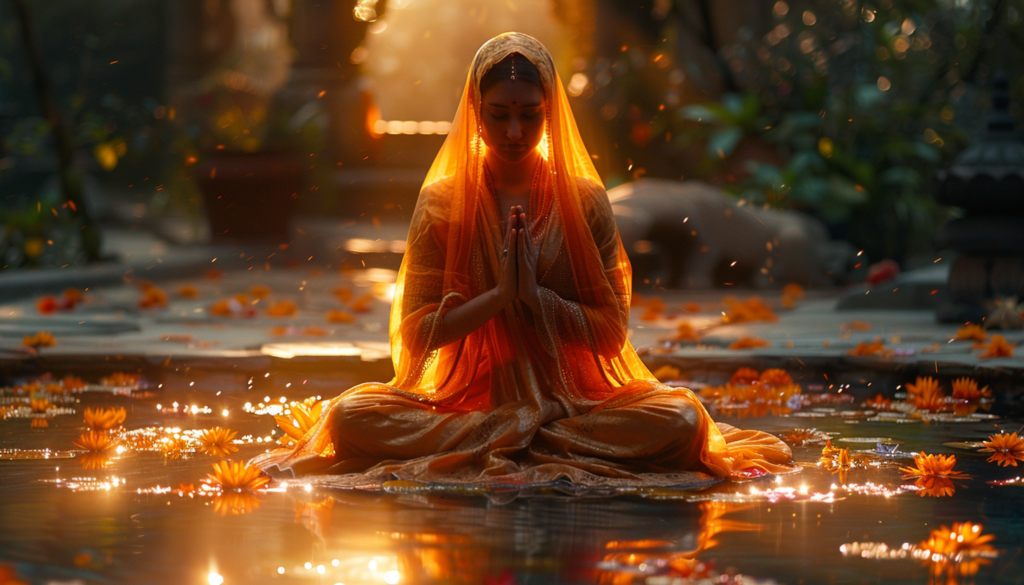Mudras, the ancient practice of symbolic hand gestures, hold a revered place in the realms of yoga and meditation. Originating from the Sanskrit word “Mudra,” meaning “seal” or “gesture,” these hand positions are not merely physical actions but are imbued with profound spiritual and health-related significance. Historically, mudras have been pivotal in various Eastern spiritual traditions, including Hinduism and Buddhism, serving as a means to express and channel divine energies during meditation and ritual practices. In today’s wellness-centric world, mudras are celebrated for their ability to enhance the meditation experience, promote mental clarity, and foster an inner sense of peace. This introductory section aims to unfold the mystery surrounding mudras, offering insight into their origins, significance, and the transformative power they hold over practitioners’ physical and spiritual well-being.
Types of Mudras and Their Meanings
Gyan Mudra (Gesture of Knowledge)
The Gyan Mudra is perhaps the most recognized mudra, symbolizing the union of individual consciousness with universal consciousness. To perform, the thumb and index finger are touched together, forming a circle, while the other fingers remain extended. This gesture is believed to enhance concentration, memory, and a deep sense of calm.
Vayu Mudra (Gesture of Air)
This mudra aims to regulate the element of air within the body, associated with the nervous system and movement. By folding the index finger towards the palm and pressing it with the thumb, while the other fingers remain straight, practitioners can alleviate conditions such as gout, flatulence, and joint pain, promoting physical balance.
Agni Mudra (Gesture of Fire)
Also known as the Surya Mudra (Gesture of the Sun), the Agni Mudra increases the fire element within the body. This is achieved by pressing the thumb against the ring finger, which helps to stimulate the thyroid gland, aid digestion, and boost metabolism, contributing to physical vitality and weight management.
Mudras are a gateway to understanding the interconnectedness of the body and mind, with each gesture designed to harmonize the flow of energy within. By integrating these mudras into daily meditation and yoga practices, individuals can unlock a myriad of physical, mental, and spiritual benefits, fostering a holistic approach to health and well-being.
Benefits of Practicing Mudras
The practice of mudras transcends mere physical exercise, offering a plethora of benefits that touch on physical health, mental clarity, and spiritual awakening. Here’s how these symbolic gestures can positively impact various aspects of your life:
Physical Benefits
Mudras, by their nature, are designed to influence different parts of the body and its energetic system. For instance, the Prana Mudra is believed to invigorate the life force within, enhancing vitality and boosting the immune system. Similarly, Apana Mudra aids in detoxification and improves digestion, illustrating how mudras can contribute to physical wellness and disease prevention.
Mental and Spiritual Benefits
On the mental front, mudras such as the Gyan Mudra are celebrated for their capacity to enhance concentration and memory, making them invaluable tools for students and professionals alike. Spiritually, mudras facilitate a deeper connection with the self and the universe. The Dhyana Mudra, used in meditation, promotes a state of deep inner peace and spiritual enlightenment, illustrating the profound mental and spiritual upliftment mudras can provide.
How to Incorporate Mudras into Your Meditation and Yoga Practice
Incorporating mudras into your meditation and yoga routines can amplify the benefits of these practices, creating a more focused and enriched experience.
Timing and Duration
Mudras can be integrated into your daily practice, with each session lasting from a few minutes up to fifteen minutes or more, depending on the individual’s comfort and the specific goals of the practice. Early morning, during meditation or yoga, is considered an ideal time to practice mudras, setting a positive tone for the day ahead.
Combining with Breathing Techniques
To maximize the effects of mudras, pair them with specific breathing techniques or Pranayama. For instance, the Gyan Mudra coupled with deep, diaphragmatic breathing can enhance mental clarity and relaxation. This synergistic combination of mudras and breathwork profoundly deepens the meditation and yoga experience, promoting a sense of harmony and balance within.
Scientific Perspective on Mudras
While the study of mudras is still burgeoning in the scientific community, preliminary research and anecdotal evidence suggest that these gestures can have tangible benefits. Studies have pointed to the positive effects of mudras on stress reduction, improved concentration, and even pain management. The subtle yet significant impact of mudras on the body’s energy system and neurological functions hints at a fascinating intersection between ancient wisdom and modern science, promising areas for future exploration and validation.
Mudras in Different Cultural Contexts
Mudras have found their expression not only in spiritual practices but also in the rich tapestry of cultural traditions worldwide. In classical Indian dance forms like Bharatanatyam and Kathak, mudras are used extensively to convey complex emotions and narrate stories, demonstrating the versatility and expressive power of these gestures. Additionally, in Buddhist and Hindu rituals, mudras serve as a symbolic language, facilitating communication with the divine and enhancing the spiritual potency of the rites.
Mudras offer a window into the soul, a tool for transformation that harmonizes the body, mind, and spirit. As we explore and integrate these ancient gestures into our practices, we unlock new dimensions of health, awareness, and inner peace. The journey into the world of mudras is not just about adopting hand gestures; it’s about tapping into the latent power within us, fostering a deeper connection with the cosmos. Whether you are new to mudras or looking to deepen your practice, the journey promises to be enlightening and enriching, a testament to the timeless wisdom of ancient traditions.

